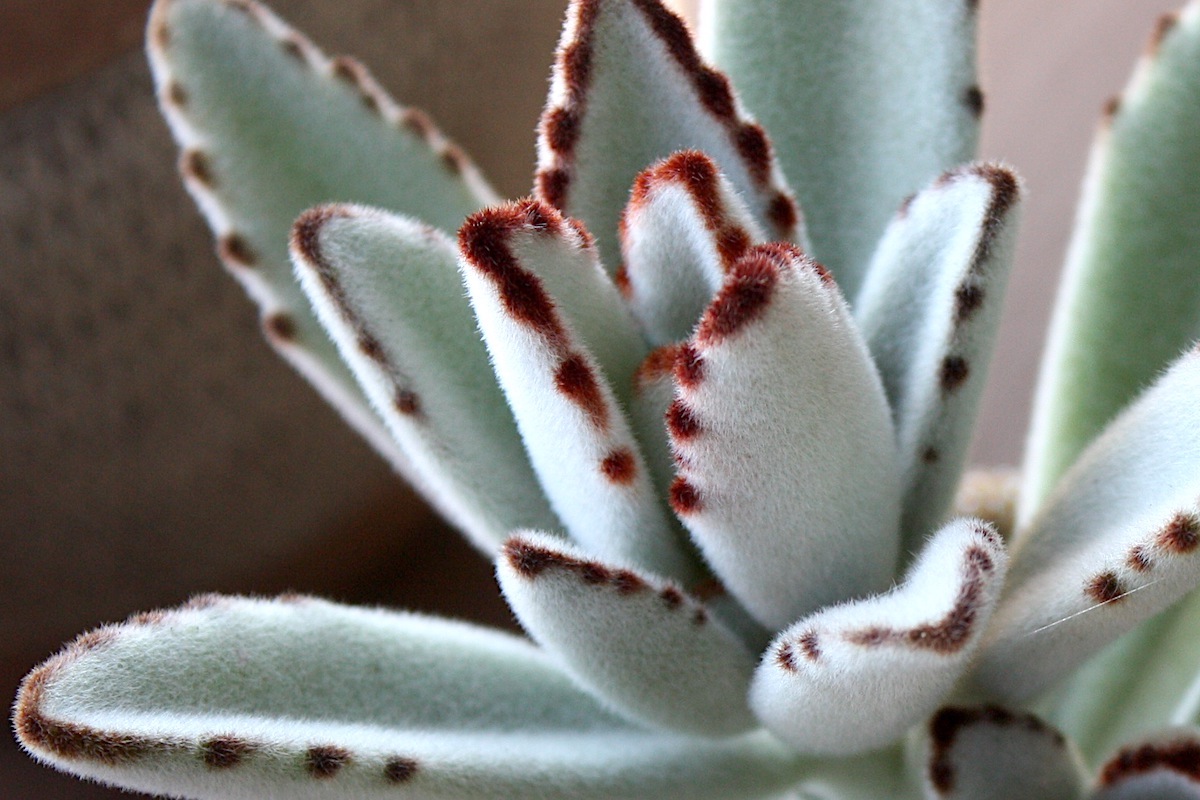
Fuzzy Kalanchoes: Varieties, Uses, Tips
I'm eager to share with you my fondness for fuzzy kalanchoes! The varieties and design uses of these unusual succulents are diverse and wonderful. I've included important tips to ensure your success with them.
The first time I saw a fuzzy kalanchoe, of course I had to touch it. It proved as photogenic as it was pettable. When backlit, velvety, fingerlike leaves glowed. Brown dashes along leaf margins suggested the stitches of a plush toy.
 Face pot of Kalanchoe tomentosa (panda plant) at the Children's garden at the San Diego Botanic Garden.
Face pot of Kalanchoe tomentosa (panda plant) at the Children's garden at the San Diego Botanic Garden.
Tomentose (fuzzy) kalanchoes thrive in pots, and look good solo or combined with crassulas, sedums and other small succulents. Their pet-me texture is striking in contrast with smoother leaves and glossy pot glazes. Most make good gifts for kids and adults alike.
In this post you'll see and discover:
- Silvery-blue Kalanchoe tomentosa (shown above)
- Golden-brown 'Chocolate Soldier' and 'Teddy Bear'
- Dainty white Kalanchoe eriophylla
- Kalanchoe orgyalis (copper spoons)
- Kalanchoe bracteata (silver teaspoons)
- Treelike, tricky-to-grow Kalanchoe beharensis (felt bush).
- A desirable one I saw on the Laguna Beach garden tour (want!).
Where can you find them?
If you're in Southern CA, see my list of succulent specialty nurseries. If you're buying online, your best bet is Mountain Crest Gardens (affiliate link).
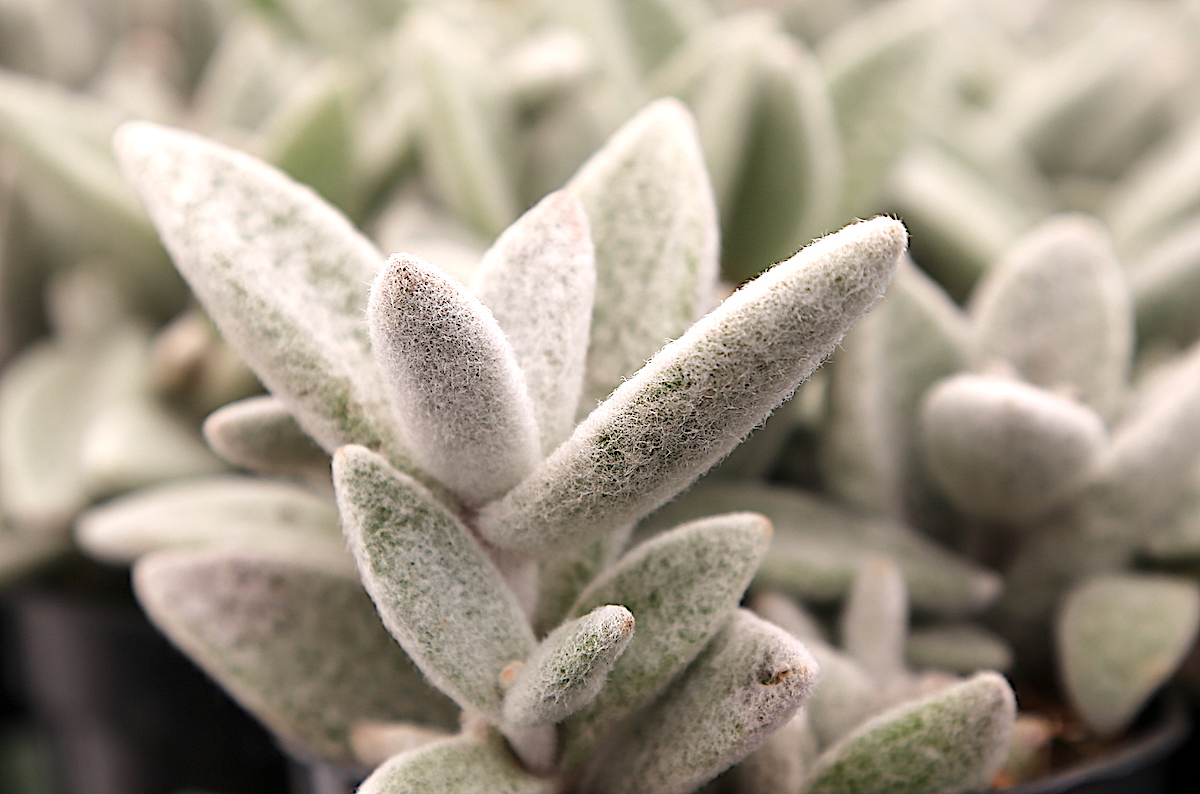 Kalanchoe eriophylla
Kalanchoe eriophylla
Above: Snow White panda plant (Kalanchoe eriophylla) is a diminutive novelty succulent useful for adding interest to container gardens.
Why the fuzz?
Fine hairs help to shade the plant, deflect the sun's ultraviolet rays, keep pests away, and lessen moisture loss.
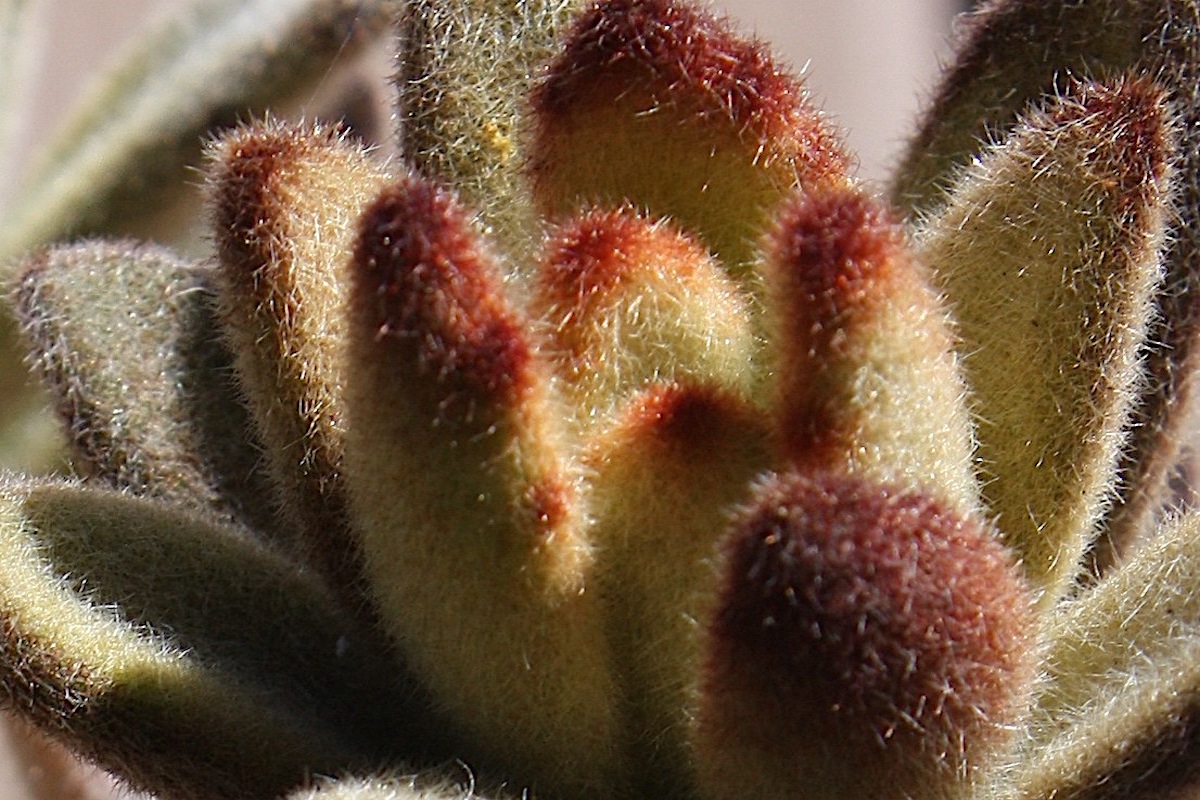
Kalanchoe tomentosa 'Teddy Bear'
Above: Kalanchoe tomentosa 'Teddy Bear' is an Altman Plants introduction.
Kalanchoe tomentosa (panda plant)
Kalanchoe tomentosa (panda plant) and its cultivars are among the easiest succulents to grow and excellent for beginners. One small nursery plant, after a year's growth, will yield three or more cuttings you can use to start new plants.
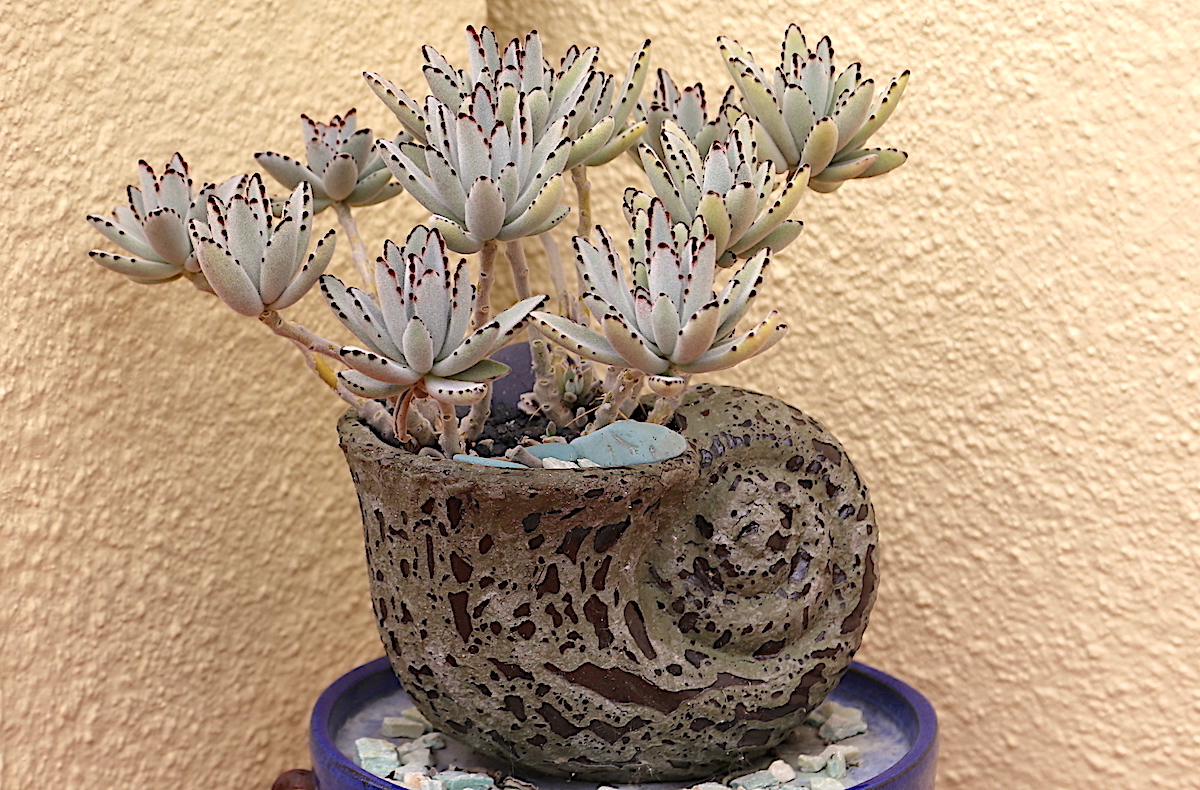 I love the color and texture repetition of this pot pairing, don't you?
I love the color and texture repetition of this pot pairing, don't you?
The Kalanchoe tomentosa in the photo above is getting a bit leggy---meaning rosettes perch atop denuded stems. Fuzzy kalanchoes typically need refreshing sooner or later. See how, step-by-step, on this site's Kalanchoe page.
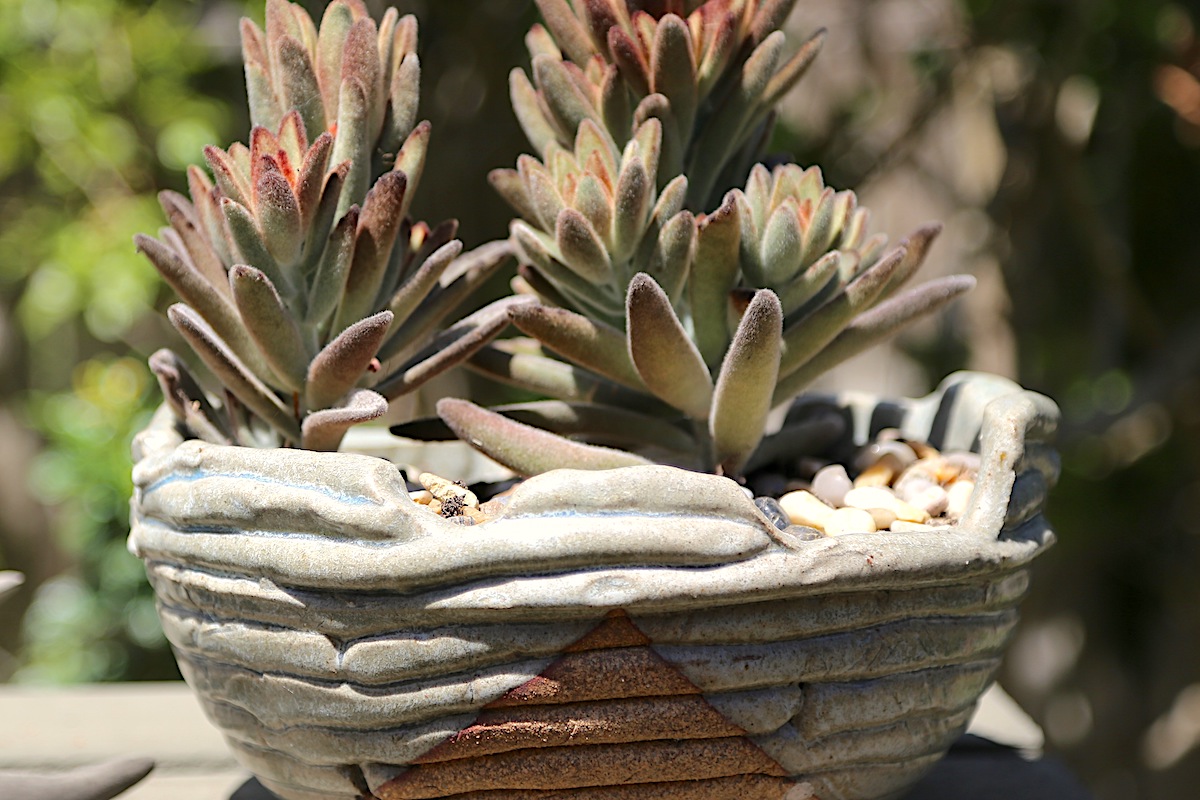 Above: Kalanchoe tomentosa 'Chocolate Soldier' repeats aspects of a one-of-a-kind art pot. Pairing by Diana Clark.
Above: Kalanchoe tomentosa 'Chocolate Soldier' repeats aspects of a one-of-a-kind art pot. Pairing by Diana Clark.
Silvery-blue panda plant---the most common of the fuzzies---is a go-to succulent when I want to repeat a container's blue-gray hue. Golden brown cultivars of Kalanchoe tomentosa provide a similar effect in warmer-toned pots.
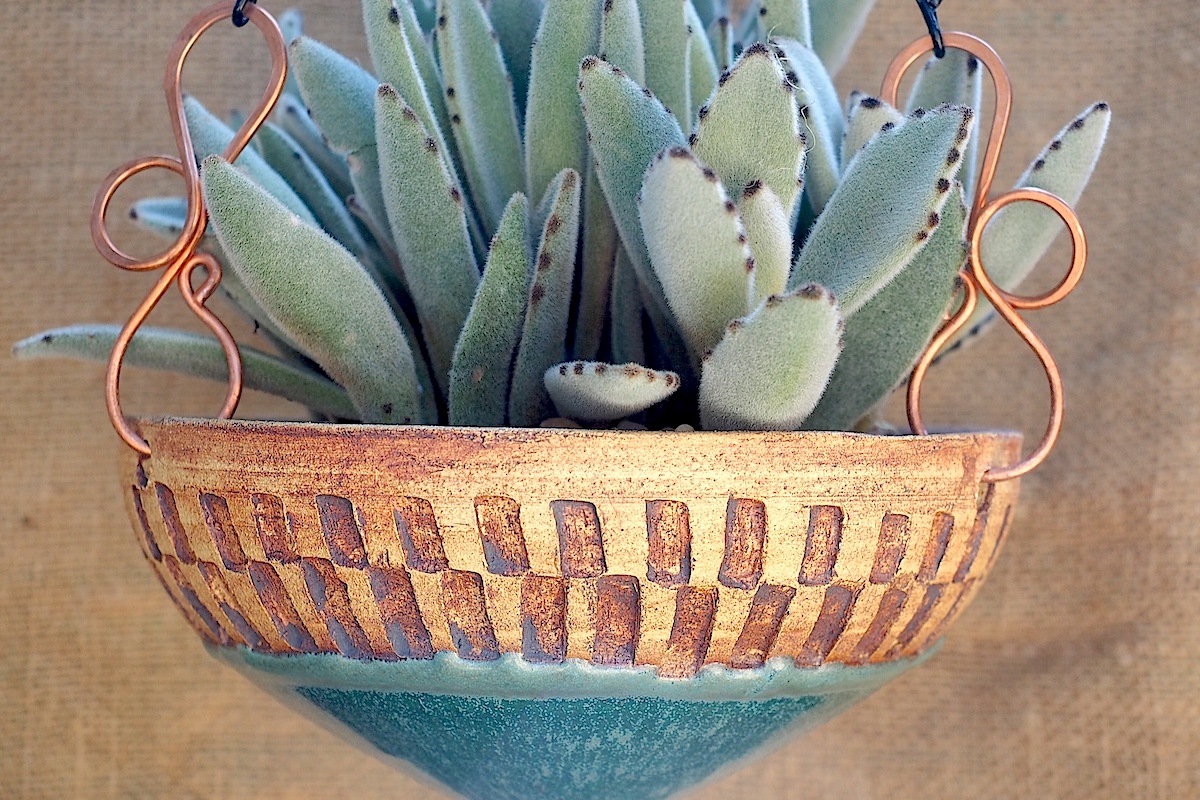 This Kalanchoe tomentosa graces a hanging pot by Alicia Iraclides of Potted Arts. See us at the nursery making plant selections, and watch how they came together in the video: How to Pair Succulents with Hanging Pots (5:45).
This Kalanchoe tomentosa graces a hanging pot by Alicia Iraclides of Potted Arts. See us at the nursery making plant selections, and watch how they came together in the video: How to Pair Succulents with Hanging Pots (5:45).
See panda plant in my "terrific succulents" video
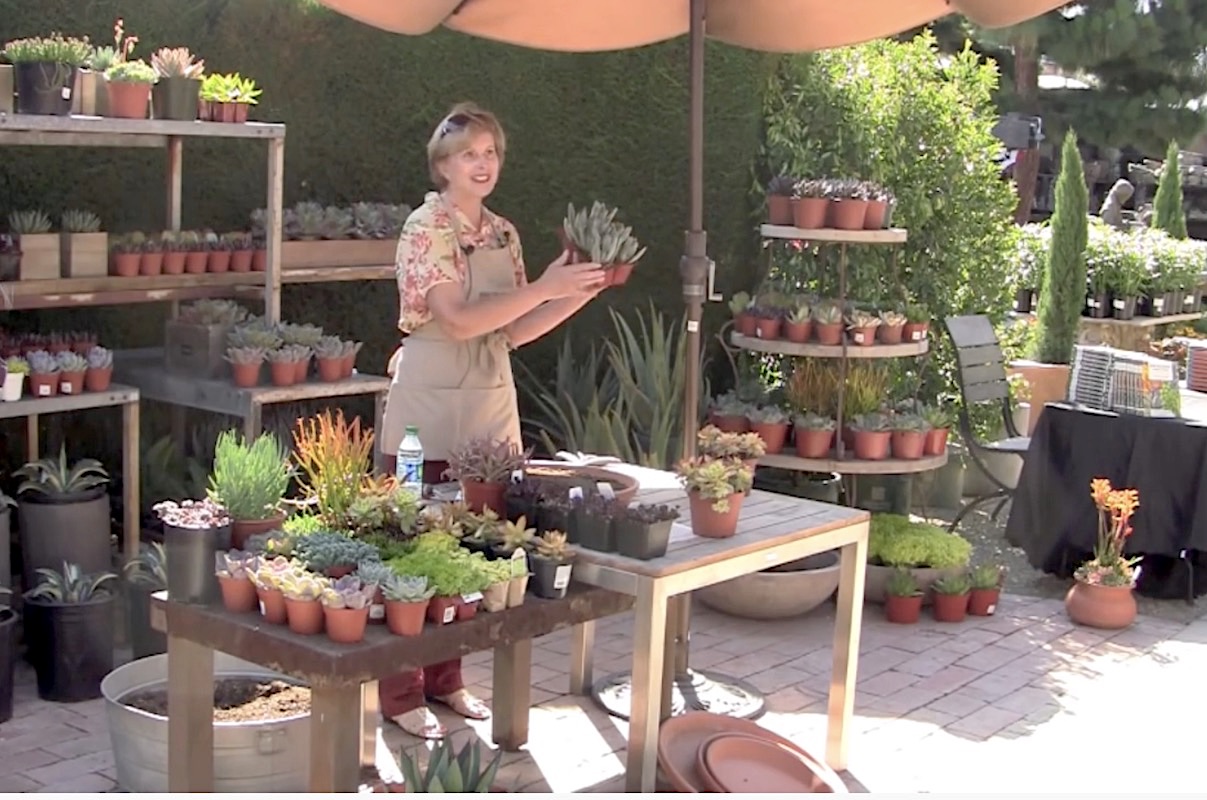 Kalanchoe tomentosa (panda plant) is one of "Ten Terrific Colorful Succulents" I show in a presentation, above, at Roger's Gardens nursery. See it beginning at 5:25.
Kalanchoe tomentosa (panda plant) is one of "Ten Terrific Colorful Succulents" I show in a presentation, above, at Roger's Gardens nursery. See it beginning at 5:25.
Felt bush and 'Fang'
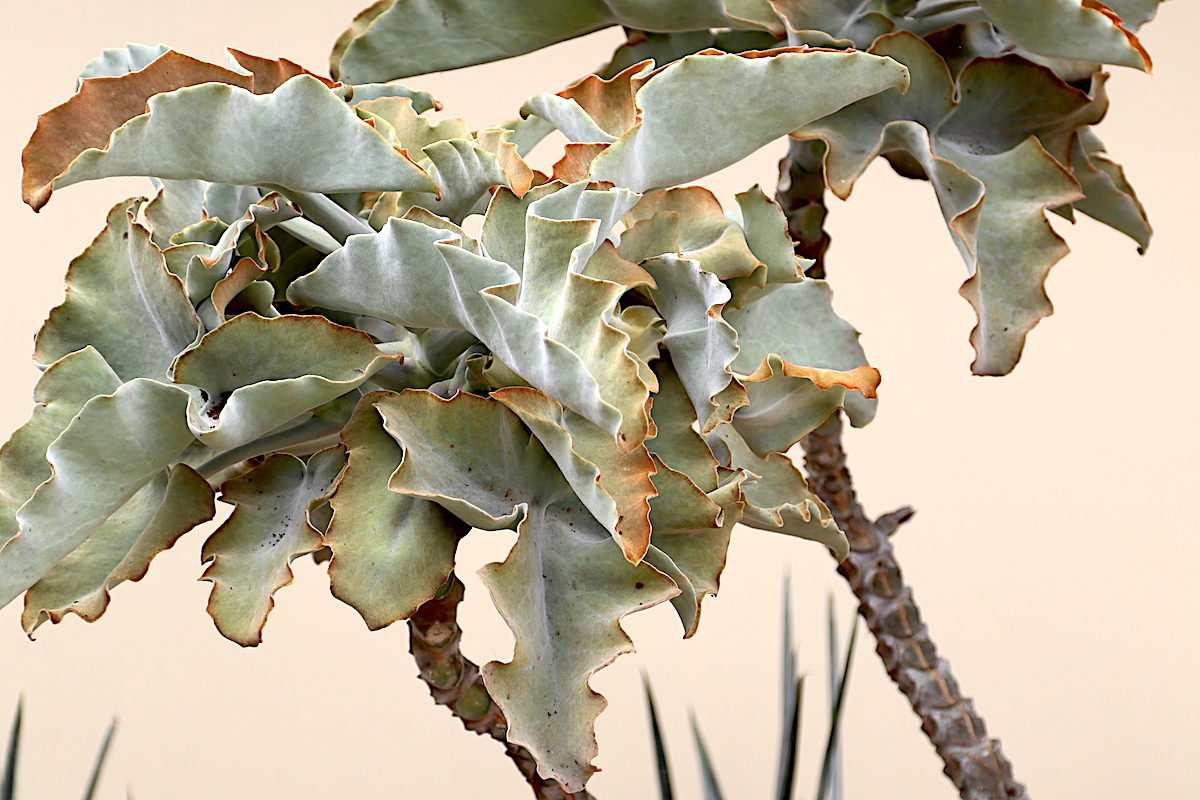 Kalanchoe beharensis (felt bush, Napoleon's hat). Photo from my book, Designing with Succulents (2nd ed.)
Kalanchoe beharensis (felt bush, Napoleon's hat). Photo from my book, Designing with Succulents (2nd ed.)
Treelike Kalanchoe beharensis, named after Behar, a town in southern Madagascar, grows to about six feet tall. Arrowhead-shaped leaves average 18 inches long. A wonderful aspect of this large succulent and its whiskery cultivar 'Fang' is that you can grow new plants from a single leaf. Lay it atop potting soil in bright shade, and as the leaf shrivels, a baby plant will grow where stem meets leaf.
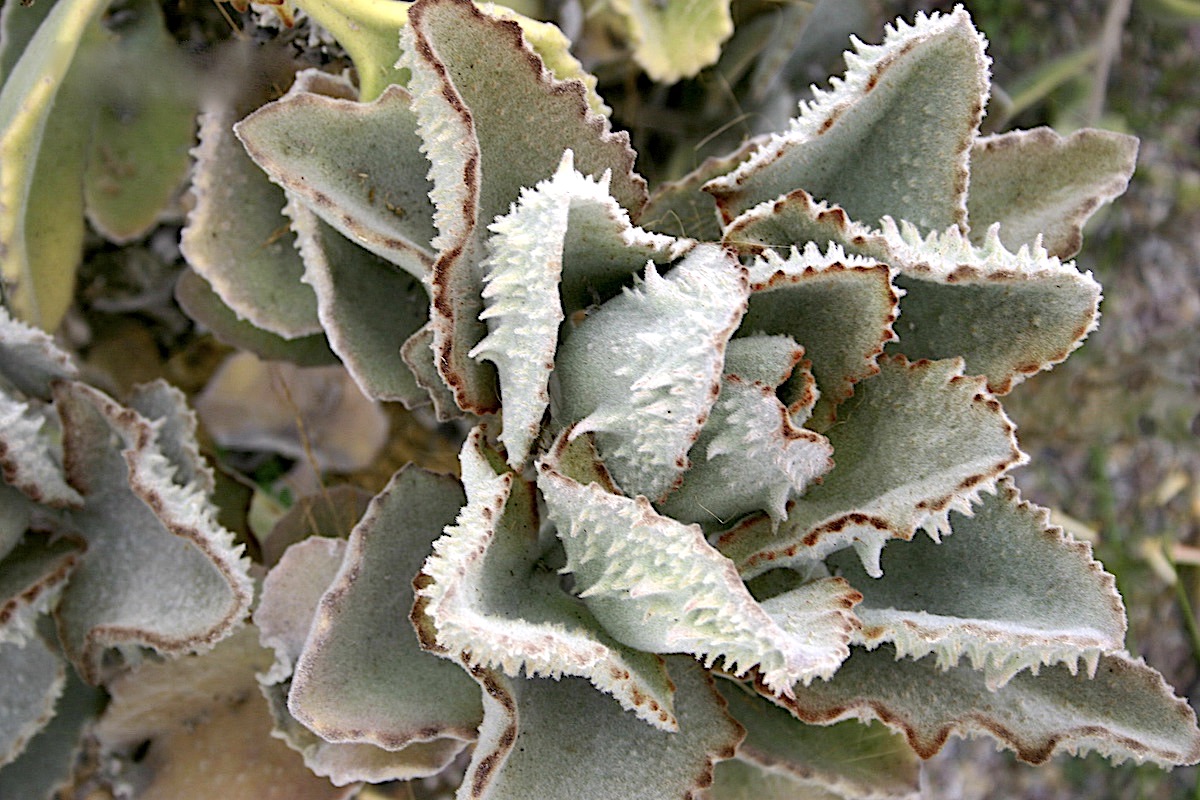 Kalanchoe beharensis 'Fang'
Kalanchoe beharensis 'Fang'
It's tempting to plant treelike kalanchoes in the garden as focal points, but they can be tricky. Felt bush and 'Fang' prefer temperatures between 40 and 85 degrees, and coastal conditions like those of Santa Barbara, Laguna Beach or Coronado.
In less than ideal conditions plants lose too many leaves, exposing a spindly trunk lined with divots where leaf stems were attached. Conversely, if Kalanchoe beharensis is too happy, heavy leaf clusters can cause weak limbs to break. If necessary, prop up the branches.
Copper spoons and silver spoons
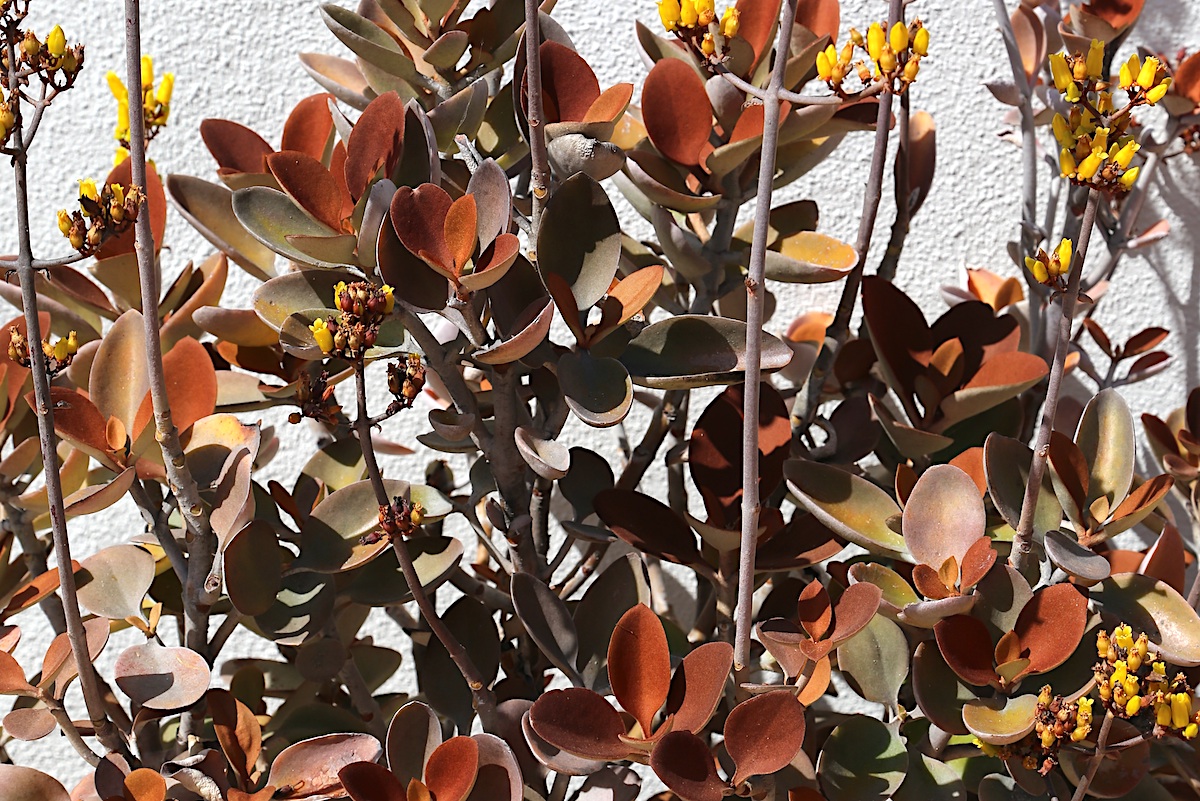 Kalanchoe orgyalis (Copper spoons)
Kalanchoe orgyalis (Copper spoons)
These oval-leaved shrub succulents seem to do best in coastal gardens. Leaves of copper spoons are velvety brown on top and silvery gray underneath; tubular, upright flowers are bright yellow on branching stems.
Silver spoons (Kalanchoe bracteata, below, with red flowers) looks similar to Kalanchoe orgyalis, but leaves are silver-gray. It's often confused with nearly identical Kalanchoe hildebrandtii, which has greenish-yellow flowers.
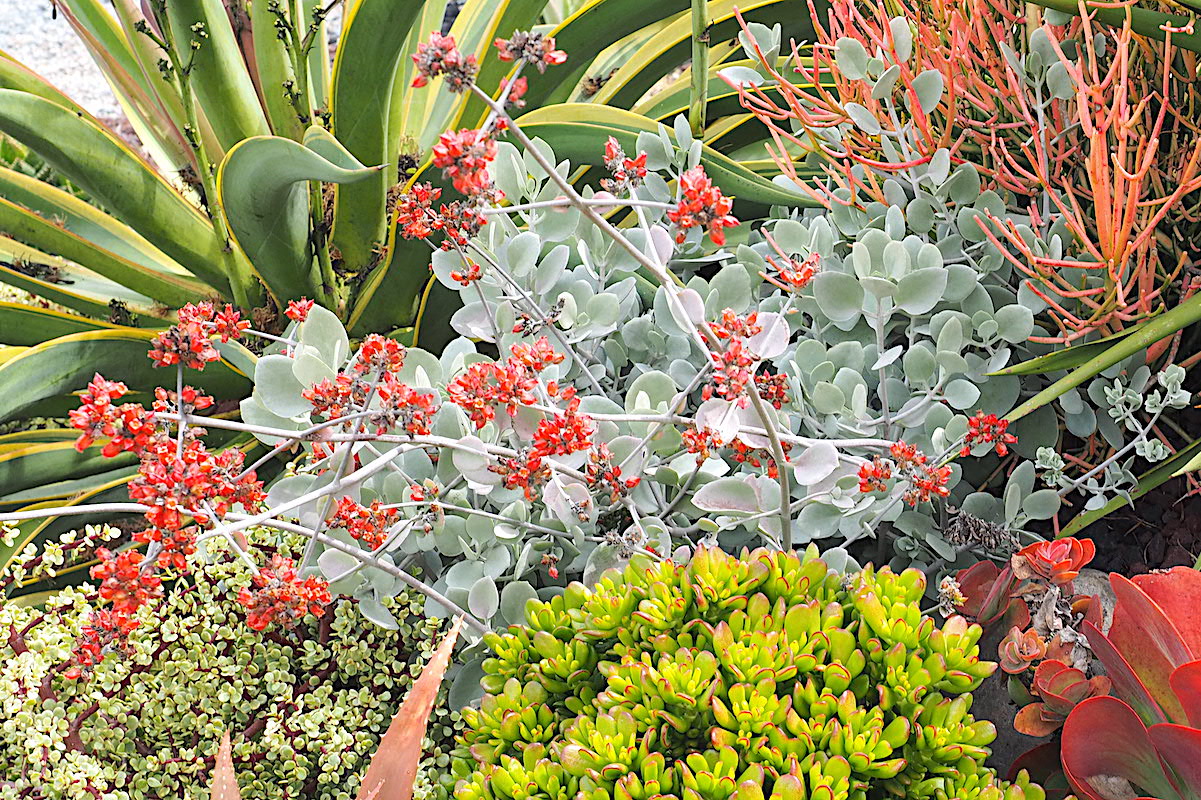 Kalanchoe bracteata in bloom
Kalanchoe bracteata in bloom
Above: Isn't this a gorgeous garden? In it the designer used several different fuzzy kalanchoes. See it in my video: A Colorful Succulent Garden to Copy (3:51).
The fuzzy kalanchoe on my wish list
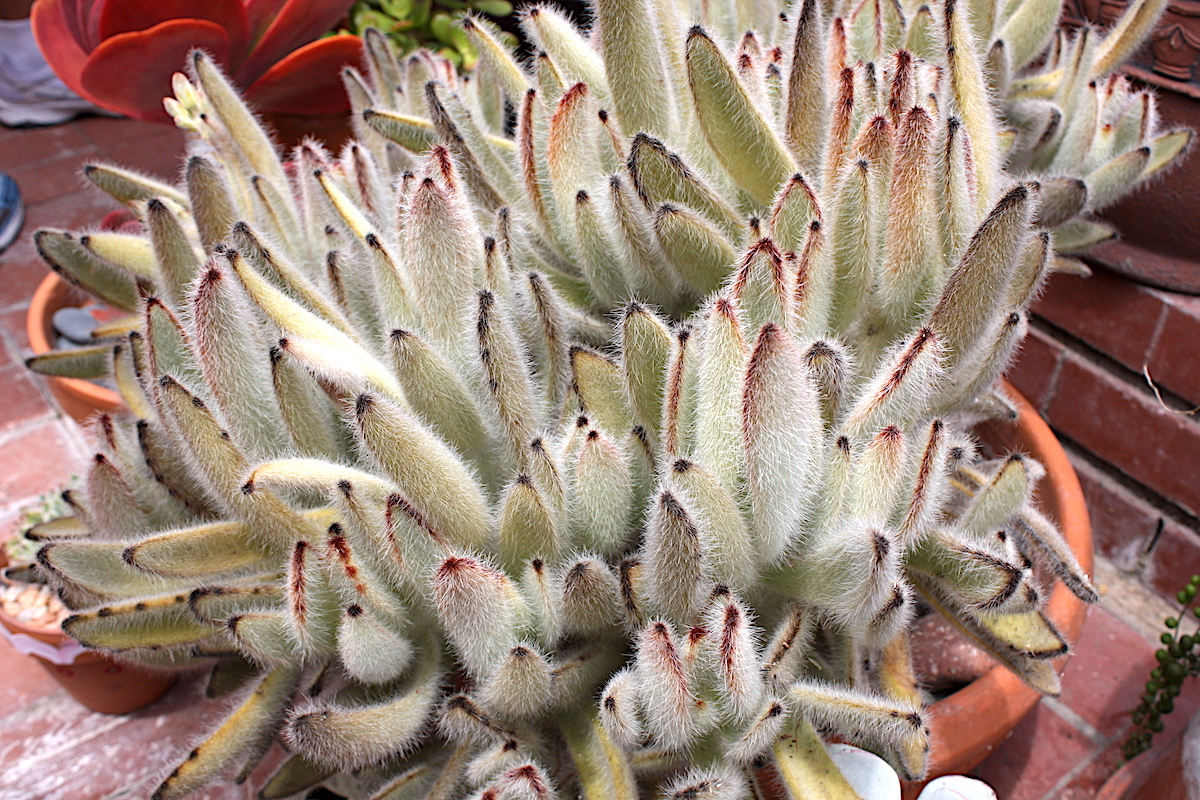 Kalanchoe tomentosa 'Super Fuzzy'
Kalanchoe tomentosa 'Super Fuzzy'
I ran across Kalanchoe 'Super Fuzzy' on a Laguna Beach garden tour ages ago. I've since looked for it everywhere. If you have a source, would you kindly LMK? Thanks!
Care and cultivation
The care, cultivation, propagation and refreshing of tomentose kalanchoes is the same for non-fuzzy varieties. Learn more on this site's Kalanchoe page.
Kalanchoe Details, Photos and Varieties
Kalanchoe: Details, Photos and Varieties Native to Madagascar, kalanchoes thrive outdoors in zone 9 (and higher if in dappled shade). Protect from frost. See All Succulent Types Aeonium Agaves Aloes Cactus Crassula Echeveria Euphorbias Ice Plants Kalanchoe Portulacaria Senecio >> Jump Down to the Gallery All the kalanchoes in the video are also in the…

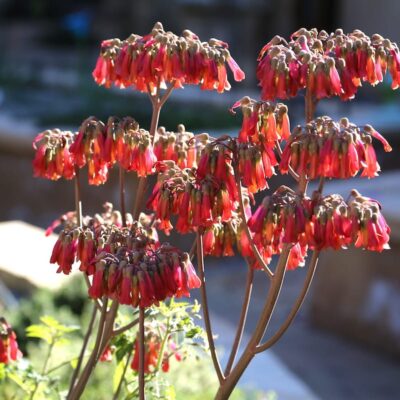
I must be a super failure in this department. I have never been able to have one survive in my possession for more than a couple months. I love the teddy bear fuzziness.
Hm. I wonder what’s going on. As succulents go, they seem pretty average in the cultivation department. I wonder if anyone else is having difficulty. Do you mind sharing a bit more…like your city or region and any other clues as to why they may have failed?
I use to have trouble with the fuzzy panda. I live in North East Georgia and found it to be exceptionally hot in July and August. I have since given in only morning sun and a shaded, breezy location in the afternoon. Give it good air flow also. They are doing great now.
Perfect! Thanks, Kristin.
I didn’t see basic info in article like how much water and sun?
Hi Mindy — “Care and Cultivation” at the end of the article sends you to the main Kalanchoe page (fuzzies are only a small percentage of the genus).
Here’s the info: Mainly from Madagascar off the coast of South Africa, kalanchoes thrive in mild, summer-dry maritime climates. Most can’t handle freezing temperatures or desert heat.
Typical of most soft succulents, kalanchoes want several hours of sun daily and bright shade for the remainder. Learn more on this site’s Succulent Care Basics page.
Plant in potting soil or cactus mix, and keep soil about as moist as a wrung-out sponge. Watch for snails on smooth-leaved varieties.
Hi, Debra… i am a Kalanchoe lovers. KI have a repeated problems of my Snow White Panda (K.eriophylla). After a couple.of months, their stems becomes “old, wood-like, dry and some of it are totally hollow”.
I could not prevent it. While the others, in the same planter, are still lovely and healthy. What is the problem ?
Hi Yurike — Yeah, they do that. You know how people say “I’m so over…” something popular? Well, that’s how I feel about K. eriophylla. I’d use it in wreaths and topiaries and it would look great for awhile and then get leggy, woody and leaves drop off. I think it’s probably an example of a highly desirable plant from the standpoint of aesthetics, so it’s widely cultivated and sold, but it’s a heartbreaker. Like lithops.
Kalanchoe Super Fuzzy is available for sale on the Etsy ship “LoveSuccsLLC”.
Thank you for the shout-out, Heather. We appreciate it! =)
I have several and there doing great even in the cold. I have mine inside but I try to keep my room warm also they like humidity so I have several glasses of water so they can evaporate put water in the air. It’s also really good for my Tarantula. So I’m stoked try keeping it your succulent inside if you see them being sad or/dieing you might be able to help it by making it warmer and the water glasses help all plants.
Hi Nicholas — LOL about the tarantula! Thanks for sharing and for the suggestions!
If you haven’t located the super fuzzy yet, I believe I found a few for sale on etsy labeled as “hairy harry”.
Ha! What a name. Thanks so much Revka!
As of two weeks ago, East Austin Succulents had Kalanchoe villosa a.k.a. “Super fuzzy” available when I was shopping in person. I purchased one, and it is gorgeous. I do not see them available for online shopping, but if you called them, perhaps they would sell you one.
What a great tip, Jeanette! Thank you!
I have Super Fuzzy 😁👍
I have a new one that I found for a dollar at my Kroger! It’s dark green and red. Any idea what type that would be?
Maybe a flapjack plant? It’s pretty common. Oval leaves.
I think I have one of those super fuzzy ones, but not sure.
Debra..were you able to find a Kalanchoe Super Fuzzy yet? I believe its also called “Hairy Harry” and is currently available at Mountain Crest Gardens ( just in case you still need one )
I meant to add links in my last post to where this super fuzzy panda plant is available. Happy Planting!
https://mountaincrestgardens.com/kalanchoe-tomentosa-hairy-harry/
also available at
https://littleprinceplants.com/our-plants/plant-solutions/prince-of-paradise/kalanchoe-tomentosa-hairy-harry-panda-plant/
Thanks, Karen!
We just bought a “Super Fuzzy” Kalalanchoe and found your page to learn more. I saw your request for where to find them, and ours came from here: https://www.yoshitomibros.com/catalog.html#!?search=Super%20Fuzzy%20Kalanchoe
Thanks, Dan! Good to know. Debra
I have a hairy Kalanchoe about 6″ tall. It has 3 pups and appears healthy except that the lower leaves are not turgid…seem to be wilting. Should I remove the lower sad leaves to make ample room for the pups? It’s a handsome plant.
That’s natural for it to lose its lower leaves. Yes, I’d remove them to make room for the pups.
I grow batches of K. tomentosa from seed collected from any cultivar that happens to flower in my garden (in Brisbane, Australia; 27 degrees south). So far I have done this with ‘Chocolate Soldier’ and ‘Golden Girl’. This winter ‘Teddy Bear’ and ‘Dorothy Brown’ are coming up to flower. You get a degree of plant to plant variation in the seedlings, which is why I do it. One of my seed-raised plants has the long narrow leaves of ‘Chocolate Solder’ but is silver like the wild type of the species. Another, very slow growing one, is looking to be a ‘Teddy Bear’ look-alike. Some have extra-deep toothing along the leaf margins.
I also have the oak-leaf form of K. beharensis coming into flower at the moment, so hoping I will be able to do the same with that (assuming it is self fertile). I also have K. millottii and the hybrid between that and K. beharensis. Both are attractive and easy, silver-felted plants.
Last year I tried hybridising K. orgyalis onto K. bracteata. I have over a dozen seedlings, some of which are mainly silver but with a copper margin around the distal end of the leaves. I’m not sure if they are actual hybrids or just youthful K. bracteata, which can have some copper colouring transiently on small plants. I’ll have to be patient, until they are larger and it becomes clear whether they differ conspicuously from K. bracteata. A couple of the seedlings are green, without the silver bloom, which was a surprise. Also some appear to have long pointed leaves rather than the normal orbicular shape.
I like to team the silver Kalanchoes with silver Mediterranean garrigue plants like the silver Artemisias, Cerastium tomentosum, and Helichrysum italicum.
Wow, very impressive, Peter! I hope you meet similar kalanchoe hybridizing enthusiasts!